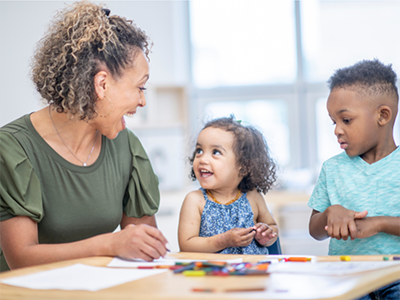How to Have Quality Conversations to Boost PreK Language Skills
Watch the Recording Listen to the Podcast
While PreK teachers obviously want to have a positive impact on students’ language acquisition, recent research shows that it’s the quality, not the quantity, of those interactions that help build a strong foundation.
In the edLeader Panel, “Creating Positive PreK Classroom Environments and Meaningful Interactions,” the presenters outlined key strategies for creating positive interactions through experiences that are “planned, purposeful, and playful.”
Know your students and the standards
Teachers should be creating intentional learning opportunities throughout the day, but they can’t do that if they don’t have clear goals in mind. They should know what the school leaders, families, and education agencies expect their students to learn at each stage of the school year. Combining this with a thorough understanding of where each student is on the learning journey, teachers can start building a plan.
Know your resources
Similarly, teachers need to be completely familiar with the tools they have to use in the classroom. This includes pre-reading all books and formulating what questions to ask to both the whole class and small groups.
Create a positive climate that welcomes all students
Provide all children with clear guidelines and expectations that they can understand, giving them a safe place to learn and explore. Instead of always calling on the student who knows the answers, connect with every student, asking follow-up questions to ensure that they all understand the book or lesson. Encourage each student to participate to the best of their ability.
Develop scaffolds for each lesson to meet each student’s needs
Just as you want to have each student participate in the classroom, you also need to create opportunities for each student to progress. The presenters recommend having small group lessons every day, where you can adjust the goals based on the students’ learning journeys and what support they need from you. Be ready to scaffold up or down within a lesson depending on their responses.
Integrate positive language interactions in every day
The presenters discussed three key opportunities for quality conversations:
- Interactive read-alouds in big and small groups: Here, the teacher doesn’t just read the story to the students but asks key questions throughout the lesson. In addition, the teacher should encourage students to talk with each other about the book.
- Play-based activities: This is a form of guided play where the teacher acts more like a stage master, prompting the activities with questions, inviting them to ask have discussions with each other, and stepping away when the students are having meaningful conversations on their own. Incorporate the books used in other lessons, as well as writing prompts, in these activities.
- Small group activities: Again, these are lessons geared towards the needs of each set of students. But rather than pulling them together when the teacher notices an item that needs attention, these are planned as part of the daily curriculum.
Strive for five
In addition to creating opportunities for conversations, the presenters advocated making sure that they aren’t just one-question, one-answer interactions. They offered a model of having at least five parts to a conversation (question, answer, follow-up question, answer, teacher response) so that each child is equally engaged by the instructor.
Get families involved
In order for students to continue their language acquisition, they need to have positive interactions at home as well. Work with families to figure out how they can offer the same opportunities at home that you do at school. Be clear that you aren’t expecting them to be the teacher, but you’re offering them a way to connect their home life and school life.
Finally, school leaders need to make sure they understand how these methods are working—or not—in the classroom and support their teachers. Moving towards quality interactions shouldn’t come with a prescriptive checklist for educators. Instead, work with them to understand what they are already doing in the classroom, where they need help, and how the administration can support them.
Learn more about this edWeb broadcast, “Creating Positive PreK Classroom Environments and Meaningful Interactions,” sponsored by Scholastic Education Solutions.
Watch the Recording Listen to the Podcast
Join the Community
Engaging Early Learners is a free professional learning community that provides PreK to grade three educators and administrators with a place to collaborate on teaching and nurturing the young learners under their care.
Scholastic Education Solutions provides teachers, families, and communities with the tools they need to support each and every child with print and technology-based learning programs for pre-K to grade 12, expert professional development, family and community engagement, and learning supports.
Blog post by Stacey Pusey, based on this edLeader Panel





Comments are closed.